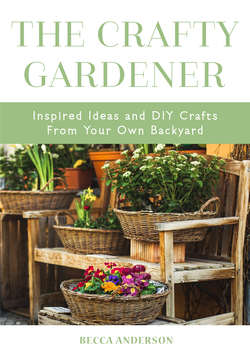Читать книгу The Crafty Gardener - Becca Anderson - Страница 22
На сайте Литреса книга снята с продажи.
ОглавлениеTo live happily is an inward power of the soul.
—Marcus Aurelius
Make Your Own Mini-Pond
All it takes is a watertight container and a few plants. You can use half-barrels, if you line them with PVC liner (available at garden centers), or ceramic pots, as long as you seal them with two coats of sealant. Plastic pots require no preparation. Use plants with contrasting shapes to create an appealing design, but don’t use too many different ones; you’re working in a small space, and too much variety will look chaotic. And remember—they will grow, so take that into account in your design. You just submerge the pot, dirt and all, into the water. You can get height differentials by setting the plants on submerged bricks or overturned pots. Good water plants include water lettuce, water hyacinth, sweet flag, parrot feathers, cannas, calla lilies, giant arrowhead, yellow pitcher plant, and water celery. Fertilize with pellets available at any nursery. If you live in a place that freezes, bring the plants in to use as houseplants for the winter, or keep them in a tub of water in the basement. They most likely will need to be divided in the spring. Start another pond or give the new ones away.
We are not sent into this world to do anything into which we cannot put our hearts.
—John Ruskin
Nourishing Body and Soul
My faith is all a doubtful thing,
Wove on a doubtful loom,
Until there comes, each showery spring
A cherry tree in bloom.
—David Morton
Elderflower Elegance: DIY Tonic
If you live in an area where elderflowers grow, here’s an old-fashioned skin tonic. This is a great gift when packaged in a beautiful glass bottle decorated with an old botanical illustration of an elderflower. Be sure to include storage instructions.
•50 elderflower heads, washed in cold water
•a 1-quart jar, sterilized
•2 ½ cups water
•5 tablespoons vodka
•cheesecloth
•decorative glass bottles with lids
Remove petals from heads, making sure not to bruise the flowers; do not include stems. Place petals in quart jar. Boil water and pour over flowers. Let stand for 30 minutes, and add vodka. Cover and let stand on counter for 24 hours. Pour liquid through cheesecloth into glass bottles and cap. Store in refrigerator until used, then keep in cool, dry, dark place, like a cabinet, and use within one month. Makes 3 cups.
Welcome Your Backyard Neighbors: Giving Birds a Home
Birds really do like birdhouses, as long as you make them hospitable. Make a birdhouse fit into its surroundings, both in color and texture, as much as possible (twigs, bark, and unpainted materials are best; birds don’t want to feel on display).
Place any house at least six feet off the ground and away from foot and cat traffic. Face it away from the sun, preferably in trees or shrubs. Don’t despair if a bird doesn’t move in until the second year the house is there; they need time to get used to it. One easy bird-friendly option is to buy a standard birdhouse at a store and hot-glue straw or dried grasses to the roof, creating a natural thatched effect. For more elaborate handmade houses, consult The Bird Feeder Book by Tom Boswell (Lark Books) and the Bird House Book by Bruce Woods and David Schoonmaker (also Lark Books). Lark (800-284-3388) also has a number of birdhouse and bird feeder kits for sale.
Birds are as important as plants in my garden.
—Anne Scott-James
Grow Your Own Sponge
Did you know that you can grow your own loofah sponges? They are actually gourds (genus Luffa) and are available through many garden catalogs. Plant now and you can harvest next fall, not only for your family, but also to give as gifts. To use, let the gourd ripen on the vine (it turns from green to yellow as it ripens). But don’t let it get fully yellow—slightly green means it will be a more tender sponge. When it’s time to harvest, cut it off the vine, peel the skin like an orange, and let the gourd dry for about ten days. Then cut it open from the big end, remove the seeds by shaking, and strip off any remaining skin. Rinse the inside fibers and then submerge the sponge in water for 12 hours. Peel off the outside layer if any remains, and dry in the shade. If the sponge is too hard, you can soften it by boiling it in water for 5 minutes.
No occupation is so delightful to me as the culture of the earth…and no culture comparable to that of the garden…but though an old man, I am but a young gardener.
—Thomas Jefferson
Spring Cleaning for Body and Soul
You can give your skin a great spring cleaning with all-natural products.
For oily skin: Mix 1 egg white and 1 tablespoon of oatmeal. Apply in a thin layer to face and neck and leave on for 15 to 20 minutes. Egg white contains papain, a natural enzyme that eliminates subcutaneous dirt and oil: the oatmeal is rich in protein and potassium and will give your skin a vital mineral boost.
For dry skin: Spread a thin, even layer of honey on face and neck, taking care to avoid eyes. Honey is a natural humectant and traps moisture in the skin.
Homemade Alpha-Hydroxy Mask: Cook half of a diced and peeled apple in ¼ cup of milk until soft and tender. Mash, then cool to room temperature and apply to skin. Thoroughly cleanse with warm water after 15 to 20 minutes.
